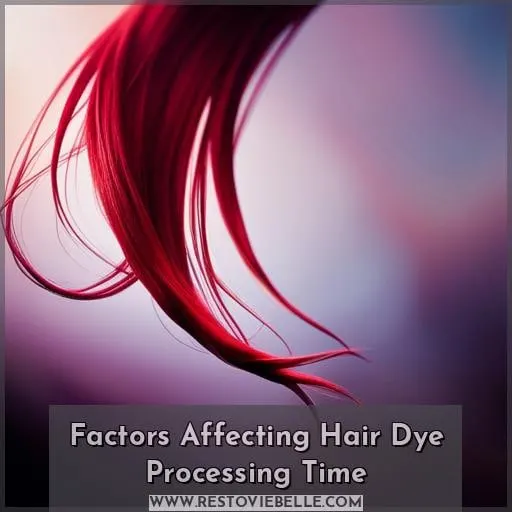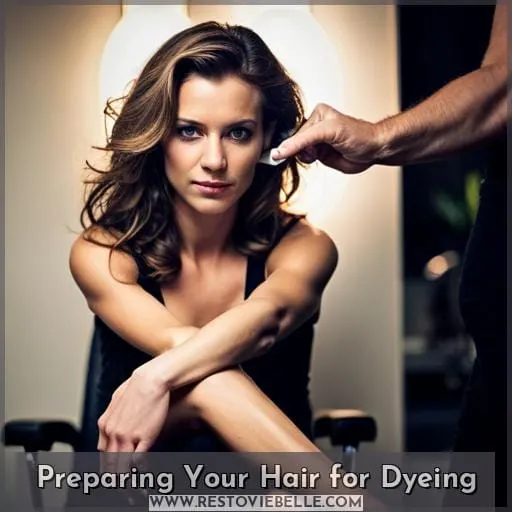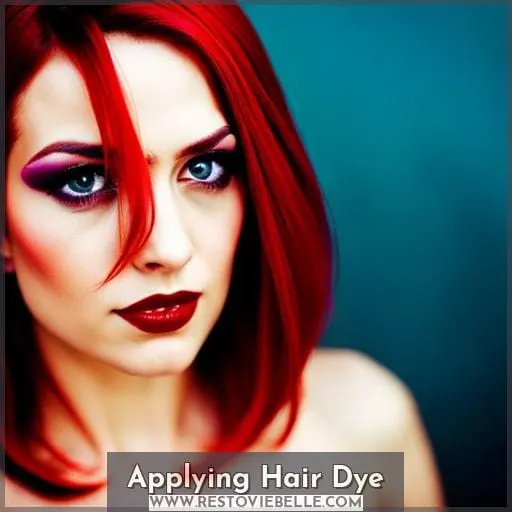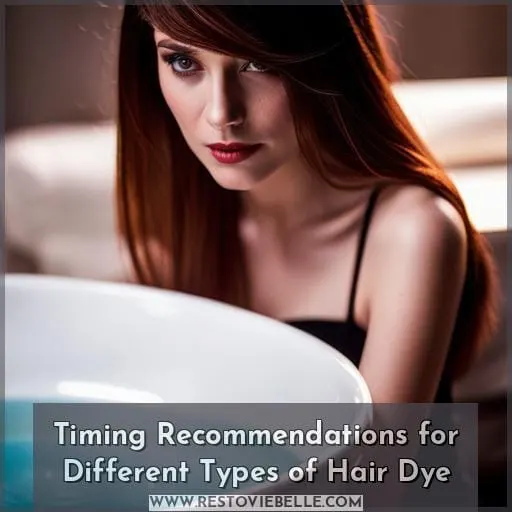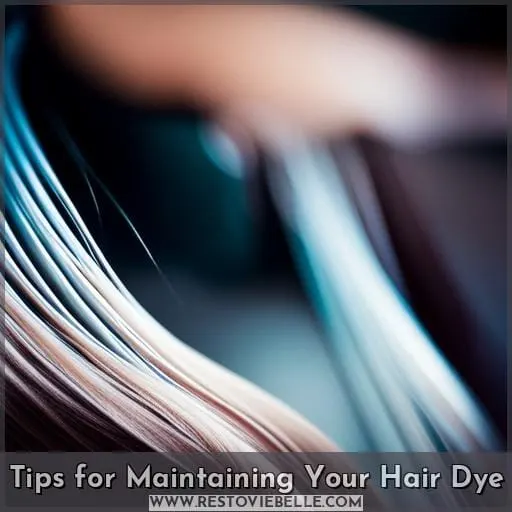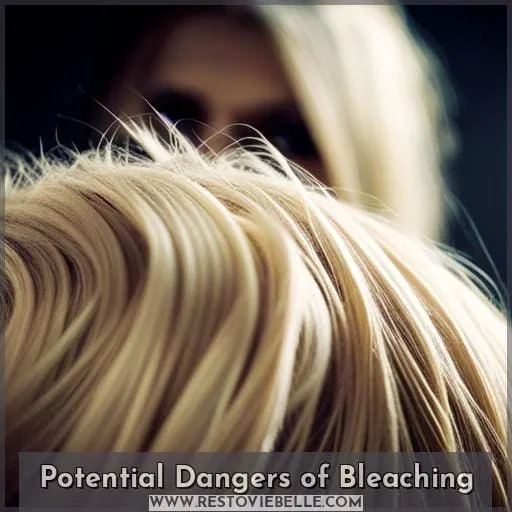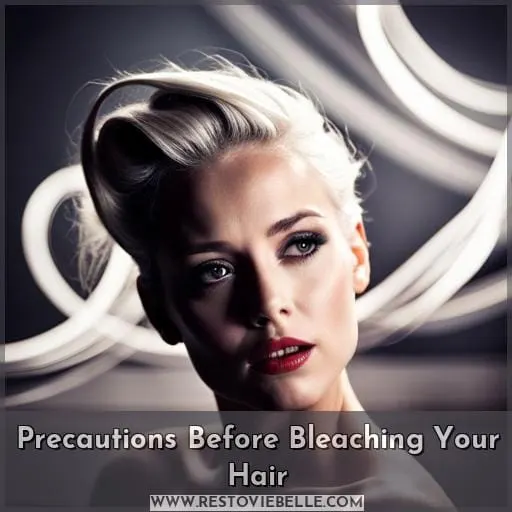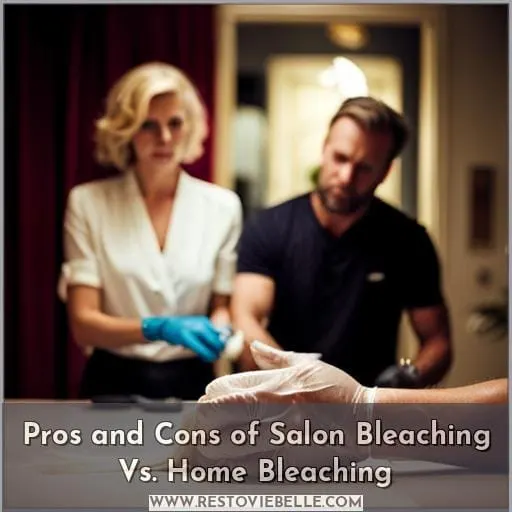This site is supported by our readers. We may earn a commission, at no cost to you, if you purchase through links.
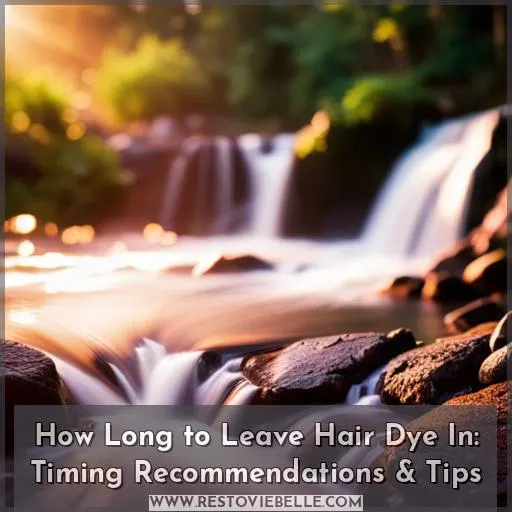 Imagine finally dyeing your hair the perfect shade, only to have it fade within a couple of washes. Frustrating, right? That’s why knowing how long you should leave hair dye in is crucial for achieving vibrant and long-lasting results.
Imagine finally dyeing your hair the perfect shade, only to have it fade within a couple of washes. Frustrating, right? That’s why knowing how long you should leave hair dye in is crucial for achieving vibrant and long-lasting results.
In this article, we’ll delve into timing recommendations and tips that will help you avoid any color disasters. From understanding factors like porosity and gray hair to maintaining your dyed locks, we’ve got you covered on all things hair dye! So let’s dive in and get those locks looking fabulous.
Table Of Contents
- Key Takeaways
- Factors Affecting Hair Dye Processing Time
- Preparing Your Hair for Dyeing
- Applying Hair Dye
- Timing Recommendations for Different Types of Hair Dye
- Tips for Maintaining Your Hair Dye
- Potential Dangers of Bleaching
- Precautions Before Bleaching Your Hair
- Pros and Cons of Salon Bleaching Vs. Home Bleaching
- Things to Consider Before Using Henna Hair Dye
- Frequently Asked Questions (FAQs)
- Can leaving hair dye in for longer than the recommended time result in a more vibrant color?
- How long should I wait before reapplying hair dye to maintain my desired color?
- Are there any natural remedies or products that can help extend the life of my hair dye?
- What should I do if I accidentally leave the hair dye in for too long?
- Can using heat tools on my hair after dyeing it cause the color to fade faster?
- Conclusion
Key Takeaways
- Hair porosity affects dye absorption and processing time.
- Gray or white hair is more resistant and may need additional processing time.
- Follow product instructions for optimal timing based on the type of dye.
- Use after-color treatments and proper maintenance to prolong color vibrancy.
Factors Affecting Hair Dye Processing Time
When it comes to hair dye processing time, two factors that can affect how long you should leave the dye in are hair porosity and gray hair.
Hair porosity refers to its ability to absorb and hold onto color, with highly porous hair typically requiring less time for the dye to penetrate.
On the other hand, gray or white hair tends to be more resistant and may need additional minutes for optimal results.
Understanding these factors will help you determine the right timing for your specific needs when coloring your hair.
Hair Porosity
Do you know how hair porosity affects the processing time of hair dye?
Hair porosity refers to the ability of your hair to absorb and retain moisture. It plays a significant role in determining how long you should leave the dye on for optimal absorption and color penetration.
Porous hair absorbs dye more quickly, while low-porosity hair may require longer processing times. Additionally, if you’re dyeing gray hairs, they tend to be more resistant and may need extra minutes for optimal results.
Consider your porosity level when timing your DIY hair bleaching or chemical treatments to avoid discomfort and achieve desired outcomes.
Gray Hair
When dyeing your hair, it’s important to consider the factors that can affect the processing time of the dye, such as gray hair.
Gray hair presents its own challenges when it comes to optimal processing and achieving desired results. Taking care of silver strands requires extra attention and proper timing for effective color absorption.
By understanding these considerations, you can ensure that your gray hair is dyed beautifully while aging gracefully.
Preparing Your Hair for Dyeing
To ensure optimal results, it’s important to properly prepare your hair before dyeing.
Start by creating protective barriers on your skin and clothing using petroleum jelly or a barrier cream to prevent staining.
Before applying the hair dye, consider conducting a strand test to determine how the color will appear on your specific hair type and texture.
If you’re unsure about which shade or technique to choose, it’s always beneficial to seek professional consultation for guidance and recommendations.
Keep in mind that individual experimentation may be necessary as everyone’s hair reacts differently to dyes.
Finally, make sure you follow the directions provided with the product for optimal adherence and desired results.
After coloring your hair, don’t forget about after-color treatments such as using an appropriate conditioner or treatment recommended in the directions of your chosen product.
Applying Hair Dye
To apply hair dye, start by following the instructions provided on the product packaging.
Here are some key points to keep in mind when applying hair dye:
- Dye Application Techniques: Use a brush or applicator bottle for precise application and even coverage.
- Color Mixing: If using multiple shades, mix them thoroughly according to the instructions before applying.
- Scalp Sensitivity: Protect your scalp by wearing protective gloves and applying petroleum jelly along your hairline.
- Styling Post-Dye: Avoid heat styling immediately after dyeing to prevent damage and color fading.
Remember that everyone’s hair is different, so it’s important to consider factors like natural texture and sensitivity when choosing a dye application method.
It’s also crucial to take proper precautions during application, such as wearing protective eyewear and avoiding contact with eyes or skin. In case of any adverse reactions like itching or burning sensation on the scalp, remove the dye immediately.
Once you have applied the hair dye correctly according to these guidelines, follow up with appropriate timing recommendations for optimal results while keeping in mind potential risks associated with leaving it too long on your strands.
Timing Recommendations for Different Types of Hair Dye
To ensure optimal results, it’s important to follow specific timing recommendations for different types of hair dye. The duration you leave the dye in your hair can greatly impact the color fade, so it’s crucial to choose the right timing based on factors such as your hair type and porosity.
Here are some general guidelines:
| Hair Dye Type | Optimal Duration |
|---|---|
| Permanent | 30-45 minutes |
| Semi-permanent | 20-30 minutes |
| Demi-permanent | 20-45 minutes |
It’s important to note that these times may vary depending on individual factors and product instructions. Exceeding or falling short of the recommended time can lead to uneven color or quick fading.
To troubleshoot any issues with your dyed hair, consider consulting a professional stylist for personalized advice on pre-shampoo care, post-color care, and protein bond protection during dyeing techniques.
Tips for Maintaining Your Hair Dye
To maintain your hair dye, it’s important to follow a few simple tips:
-
Color-Friendly Shower: Tips for preventing color fading in the shower:
- Use lukewarm water instead of hot water to wash your hair.
- Shampoo and condition with products specifically designed for colored hair.
- Rinse thoroughly to remove any residue that may dull the color.
-
Heat Styling: Balancing style and color preservation in your routine:
- Limit heat styling tools like curling irons and straighteners to prevent damage and fading.
- Apply a heat protectant spray before using any heated styling tools.
- Opt for hairstyles that don’t require excessive heat, such as air-drying or braiding.
-
Seasonal Care: Adjusting dye maintenance for different weather conditions:
- Protect your hair from UV rays by wearing hats or using UV protection sprays during sunny months.
- During colder months, use moisturizing products like leave-in conditioners or oils to combat dryness caused by indoor heating systems.
- Consider getting touch-ups at the salon more frequently if you notice significant fading due to seasonal changes.
By following these tips, you can help extend the life of your hair dye while keeping it vibrant and healthy-looking.
Potential Dangers of Bleaching
Before diving into how long to leave hair dye in, it’s important to be aware of the potential dangers that come with bleaching your hair.
Bleaching hazards include:
- Weakening the hair
- Affecting moisture retention
- Increasing porosity levels
High-pH bleach can cause irreversible damage to the structure of your hair, making it brittle and prone to breakage.
It’s crucial for maintaining healthy and strong strands that you understand these risks before proceeding with bleaching.
To minimize damage, consider consulting a professional hairstylist who can provide expert guidance throughout the process.
They’ll help assess your hair strength and recommend appropriate timing recommendations based on your specific needs while ensuring maximum safety during this transformative journey.
Precautions Before Bleaching Your Hair
Before you bleach your hair, it’s important to take certain precautions.
One of the first steps is to conduct a patch test to check for any potential allergies or adverse reactions. This involves applying a small amount of the bleach mixture behind your ear or on your inner arm and waiting 48 hours to see if there are any negative effects.
Additionally, it’s crucial to follow protective measures such as wearing gloves and protecting clothing from contact with the bleach solution.
If you have concerns about bleaching at home, consider seeking professional guidance for alternative solutions that may be less damaging or risky.
It’s also important to prepare your hair by using pre-shampoo conditioners and post-color treatments afterwards for optimal results and minimizing damage caused by thermal styling or chemical exposure during the process.
Pros and Cons of Salon Bleaching Vs. Home Bleaching
When considering bleaching your hair, it’s important to weigh the pros and cons of salon bleaching versus home bleaching.
- Cost comparison: Salon bleaching can be more expensive due to the expertise of professionals and additional aftercare services provided. On the other hand, home bleach kits are generally more affordable but may lack professional guidance.
- Expertise debate: Hair professionals in salons have extensive knowledge and experience in hair color techniques, ensuring desired results with minimal damage. DIY bleaching at home carries a higher risk of mistakes or uneven application.
- Chemical concerns: Salon products often use high-quality ingredients that minimize damage and protect against keratin loss during the bleach process compared to some harsh chemicals found in DIY kits.
By weighing these factors, you can decide which option aligns best with your budget, desired outcomes, level of expertise required,and concerns about chemical safety for healthy-looking locks post-bleach treatment
Things to Consider Before Using Henna Hair Dye
Before using henna hair dye, there are a few important things you should consider.
Firstly, the porosity of your hair can affect how well the dye is absorbed and how long it should be left in.
Additionally, if you have gray hair, it may require longer processing times for optimal results.
Lastly, understanding the difference between permanent and semi-permanent dyes will help you choose the right option for your needs.
Hair porosity and dye absorption
To determine the ideal duration for leaving henna hair dye in, consider your hair’s porosity and how well it absorbs color.
Hair porosity impacts how easily dye can penetrate the strands, while absorption variations affect the intensity of color results.
Gray hair poses unique challenges as it may require longer processing times for optimal coverage and vibrancy.
Understanding these factors will help you achieve desired results when using henna hair dye.
Gray hair processing time
Considering gray hair processing time is essential when using henna hair dye. Gray hair poses unique challenges due to its porosity variations and resistance to color absorption.
To achieve optimal processing and gray coverage, an extended duration of dye application may be necessary. However, it’s crucial to follow timing recommendations provided by the product instructions to avoid damage from intense chemicals.
By understanding these factors, you can ensure successful color achievement while maintaining healthy-looking hair with a reconstructing product if needed.
Permanent vs semi-permanent dye
If you’re deciding between permanent and semi-permanent dye, it’s essential to understand the differences in their effects and longevity.
- Permanent dye provides longer-lasting color compared to semi-permanent options.
- Porosity of your hair can impact how well the dye adheres and how long it should be left in.
- Gray hair may require longer processing times for optimal results.
- Follow specific product instructions for recommended timing based on lightness level.
- Consider consulting a professional salon if unsure about application or desired outcome.
Frequently Asked Questions (FAQs)
Can leaving hair dye in for longer than the recommended time result in a more vibrant color?
Leaving hair dye in longer than recommended may result in a more vibrant color, but it can also lead to damage and dryness. Follow the instructions for optimal results and prioritize the health of your hair.
How long should I wait before reapplying hair dye to maintain my desired color?
To maintain your desired hair color, wait 4-6 weeks before reapplying dye.
This allows time for the previous color to fade naturally and prevents buildup.
Patience is key in achieving long-lasting, vibrant results.
Are there any natural remedies or products that can help extend the life of my hair dye?
To extend the life of your hair dye, consider using natural remedies like:
- Apple cider vinegar rinses
- Color-depositing shampoos
Additionally, protect your hair from excessive heat styling and sun exposure to prevent premature fading.
What should I do if I accidentally leave the hair dye in for too long?
If you accidentally leave the hair dye in for too long, it can lead to damage and uneven color.
Rinse it out immediately with lukewarm water until the water runs clear.
Follow up with a deep conditioning treatment to restore moisture and minimize potential damage.
Can using heat tools on my hair after dyeing it cause the color to fade faster?
Using heat tools after dyeing your hair can indeed cause the color to fade faster.
The excessive heat opens up the cuticles, allowing the dye molecules to escape, leading to premature fading.
Protect your vibrant color by minimizing heat styling and using thermal protectants.
Conclusion
To achieve vibrant and long-lasting hair color, it’s crucial to know how long you should leave dye in your hair. Factors such as hair porosity and gray hair can affect the processing time of the dye.
Following the recommended timing for different types of hair dye and maintaining your dyed locks will help extend the longevity of your color. Remember to consider the potential dangers of bleaching and the precautions to take before using henna hair dye.
